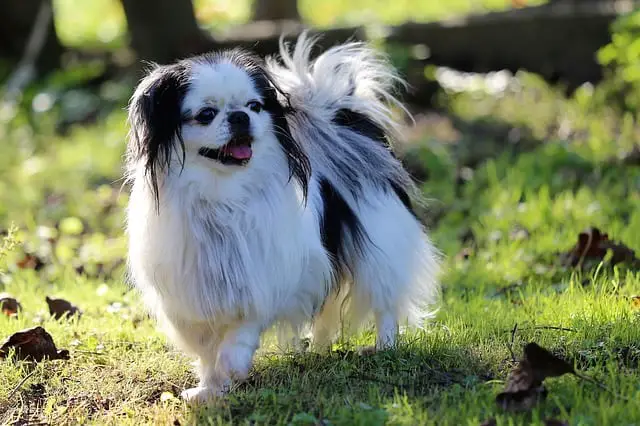
A specimen of the Japanese Chin dog breed is intelligent, sweet and charming. It shows an affectionate and docile character, but also somewhat independent, haughty and a bit stubborn. It has an appearance between elegant, aristocratic and very funny, which is why it has become over the years one of the most popular companion dogs. At Petlifey , we explain the characteristics and character of the Japanese Chin or Spaniel.
Character of the Japanese Chin or Japanese Spaniel breed
The Japanese Chin or Spaniel is a breed with a loving and independent character at the same time, docile and stubborn, conceited and modest. But above all its demeanour is aristocratic, haughty and clean, very easy to have and maintain.
Intelligent and friendly, it has a lot of personality and loves its whole family very much. However, it is very reserved with strangers, although this does not mean that it is fearful or aggressive.
Like other oriental breeds, the Japanese Chin seems to have a part of the cat in its genetic code: it is silent, reserved and very clean, as it performs an exhaustive cleaning routine at night.
And it also shows, like felines, a certain fondness for standing at a certain height from the ground, so it is recommended that their owners provide a raised chair so that from there their pet can spend hours observing everything that happens to their around.
- Energy: Medium. You need to walk and take the occasional field trip to stay in good physical shape.
- Temperament: Cheerful, affectionate and sweet, it is also independent, stubborn and somewhat haughty. Docile and intelligent, it is easy to live with him.
- Adaptability: High. It adapts to living in any environment, although it prefers to spend time indoors and, above all, in the company of its family.
- Sociability: High. It is affectionate with its family, but quite suspicious of strangers. It gets along very well with other animals.
- Health: Good. You may have respiratory and eye problems.
- Longevity: High. From 12 to 15 years old.
- Utility: Company. It is a great companion dog but it is also very useful as a therapy dog.
How do you behave with children?
He gets along very well with children, although it is important to teach them the special needs and conditions of your pet and how they should treat it to avoid any problems or altercations. It should be remembered that it is a small dog.
How does it behave with other pets?
Their relationship with other dogs and even with animals of other species is quite good and hierarchy problems rarely occur, even among specimens of the same sex. Despite this, the ideal thing is to accustom it to other animals from puppyhood.
Can you live in an apartment in the city?
This is not a noisy breed, which is an advantage for those who live surrounded by neighbors, and it adapts very well to life in any environment, whether it is in the city or in the country.
In the same way, whether it is a small apartment or a large house . But what you don’t like at all is having to spend long hours alone, in which case you may end up developing obvious signs of separation anxiety.
He also prefers to spend its time indoors, but also enjoys walks and occasional free exercise sessions outside.
Characteristics of the Japanese Spaniel breed
The general appearance of the Japanese Chin or Spaniel is that of a small dog with a distinguished and graceful appearance. This breed has a rather square body structure, with a short back, slightly raised and round.
How is the Japanese Chin race physically?
Body
It is a small dog with a rather square body structure, since its body length is approximately the same as its height at the withers, which is about 25 cm in males, and about 23 cm in females.
The back is short and straight, with a broad and slightly rounded lumbar region, while the chest is broad and deep.
Under straight legs, the Japanese Chin feet are small and elongated, and have the shape known as “hare’s” foot. They are covered with strands of hair.
The tail is set high on the rump and is usually curved on the back, falling to one side or the other. It is covered with large tufts of long, abundant hair in the shape of a plume.
Head
The head is broad and round, it has a very short and wide muzzle. Generally, the color of the nose is in line with the spots, and it can be black or deep red.
Their eyes are large and very round, they are black and very shiny. What is most striking is that they are low and far apart.
The ears are long and hanging, have a triangular shape and are covered with very long hair in the form of tufts or fringes. They are well separated from each other.
Fur
He has hair all over its body, except for its face . It is covered with abundant silky, smooth and very long hair. On the ears, the neck, the thighs, the back of the front legs and the tail, this hair forms beautiful fringes.
Colour
The mantle of the Japanese chin is white in color but has showy spots distributed symmetrically around the eyes and also on the ears, as well as on the body.
These marks can be black or red in color, and it is very common for a characteristic wide white list to appear that goes from the muzzle to the upper part of the skull.
Japanese Chin breed standard
- Origin: Japan.
- Size: Miniature.
- Height at the withers: 25 cm for males and 23 cm for females.
- Weight: between 2 and 6 kg.
- Use: Companion dog.
- Other names: Japanese Chin / Épagneul japonais / Japan-Chin.
- General appearance: With a square structure, it is a small dog, with a short back and a graceful, aristocratic and graceful appearance.
- Head: It is round in shape and has a wide and short muzzle.
- Skull: It is characterized by being broad and with rounded lines.
- Nose-frontal depression (stop): It is deep.
- Muzzle: Short and wide, the nose is in a straight line with the eyes.
- Nose: It is small and of black or intense red color, always in harmony with the color spots of the animal.
- Jaws: The jaws, equipped with strong white teeth, usually have a pincer bite, although there are also specimens in which a scissor bite or even a prognathic bite is given.
- Eyes: Very shiny black, round and large. They are located low and quite apart from each other.
- Ears: They are triangular in shape and quite long, hanging, and profusely covered with long, straight hair. They are quite far apart and are inserted not very high in the skull.
- Neck: It is rather short and the animal keeps it upright, with a haughty and aristocratic bearing.
- Body: Short and compact, it has a broad and slightly rounded lumbar region. Back: It is short and straight.
- Chest: Moderately broad and deep, the ribs are slightly arched and the belly is well drawn.
- Tail: Covered with long, abundant and beautiful hair, the dog wears it on its back.
- Forelimbs: They are straight and endowed with fine bones.
- Forearms and arms: Slender and firm, on the back they are well covered with hair in the form of showy long fringes.
- Hind limbs: They are also straight and thin.
- Legs: The back of the thighs appear covered with long fringes of hair.
- Knees: They present moderate angulations.
- Feet: Small, elongated and oval in shape, they are known as “hare’s” feet. They are covered with strands of hair.
- Movement: The Japanese Chin moves with an elegant, light movement and endowed with a certain proud bearing.
- Hair: The coat is abundant, smooth, long and white with black or red spots. The ears, neck, thighs and tail of the animal are covered with showy fringes.
- FCI Classification: Group 9 – Companion Dogs. Section 8 – Japanese and Peking Spaniels.
Education and training of the Japanese Spaniel
This breed is considered to be suitable even for inexperienced owners and does not need special care in its upbringing.
Despite this, it is always interesting to have the advice of more experienced people because, for example, if it is treated with excessive care and is allowed too many things, it can fall into the well-known small dog syndrome , with the consequent behavioural disorders that this entails.
It is important to start an intense socialization process from when the animal is a puppy of a few weeks to guarantee in this way that it can be exposed to unexpected situations without triggering strange or uncontrollable reactions. A socialized dog is always a smarter, happier and more self-confident animal.
Japanese Spaniel Health and Diseases
The Japanese Chin is a long-lived breed that easily exceeds 15 years of age and does not suffer from serious health problems under normal circumstances, although it is exposed to some conditions , many of them avoidable with correct and responsible breeding and selection.
For example, it is an animal that does not tolerate changes in temperature well , because it catches a lot of cold , and due to the peculiar morphology of its head it is not at all unusual for some respiratory problems to appear .
Likewise, the tendency to snore in these dogs is generalized and although for some it is somewhat funny, for other people it can be an annoying circumstance.
Japanese Chin breed diet

Many Japanese Chin owners forget that their dog needs to exercise to stay fit and not to gain weight.
One of the most important health problems of this breed, since being overweight increases the risk of suffering from respiratory problems and exponentially increases their chances of suffering from cardiovascular or joint diseases.
Therefore, apart from these exercise routines, it is also advisable to provide a balanced and healthy food , rich in nutrients that keep your muscles in shape and that provide the level of fat necessary for your skin, hair, eyes, etc.
